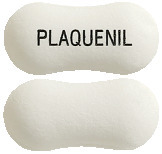1. Why am I using Plaquenil?
Plaquenil contains the active ingredient hydroxychloroquine sulfate. Plaquenil is used to treat rheumatoid arthritis and may slow down the process of joint damage and relieve the symptoms of the disease.
For more information, see Section 1. Why am I using Plaquenil? in the full CMI.
2. What should I know before I use Plaquenil?
Do not use if you have ever had an allergic reaction to hydroxychloroquine sulfate or any of the ingredients listed at the end of the CMI. Talk to your doctor if you have any other medical conditions, take any other medicines, or are pregnant or plan to become pregnant or are breastfeeding. For more information, see Section 2. What should I know before I use Plaquenil? in the full CMI.
3. What if I am taking other medicines?
Some medicines may interfere with Plaquenil and affect how it works. A list of these medicines is in Section 3. What if I am taking other medicines? in the full CMI.
4. How do I use Plaquenil?
- Swallow tablets whole with a little water or other liquid at mealtimes. The dosage will depend on why you are being treated with Plaquenil. More instructions can be found in Section 4. How do I use Plaquenil? in the full CMI.
5. What should I know while using Plaquenil?
| Things you should do |
|
| Things you should not do |
|
| Driving or using machines |
|
| Looking after your medicine |
|
For more information, see Section 5. What should I know while using Plaquenil? in the full CMI.
6. Are there any side effects?
Speak to your doctor if you have any of these less serious side effects and they worry you: nausea, vomiting, diarrhoea, abdominal cramps, loss of appetite, muscle weakness, dizziness, ringing in the ears, headache, nervousness, skin rash and itching, hair loss. Call your doctor straight away or go to the Emergency Department at your nearest hospital if you have any of these serious side effects: visual disturbances, hearing loss, suicidal behavior, frequent fevers, severe chills, bruising, sore throat or mouth ulcers (these may be signs of blood reactions), changes in the way your heart beats. Having thoughts of self-harm or suicide, feeling depressed, feeling nervous or anxious, feeling confused, agitated, difficulty sleeping, delusions, hallucinations, changes in mood, feeling elated or overexcited. Liver problems. Symptoms may include a general feeling of being unwell, with or without jaundice (yellowing of the skin and eyes), dark urine, nausea, vomiting and/or abdominal pain. Rare cases of liver failure (including fatal cases) have been observed. Kidney problems due to accumulation of phospholipids. More severe symptoms of low blood sugar levels including disorientation, seizures, fits or convulsions and loss of consciousness. Rash with a fever and flu-like symptoms and enlarged lymph nodes. Blistering, scaly skin, pus-filled spots with fever. Blistering or peeling of the skin with flu-like symptoms and fever. Skin lesions, skin itching, joint aches, fever and a general ill feeling. Reddish-purple coloured painful sores with or without a fever. For more information, including what to do if you have any side effects, see Section 6. Are there any side effects? in the full CMI.

